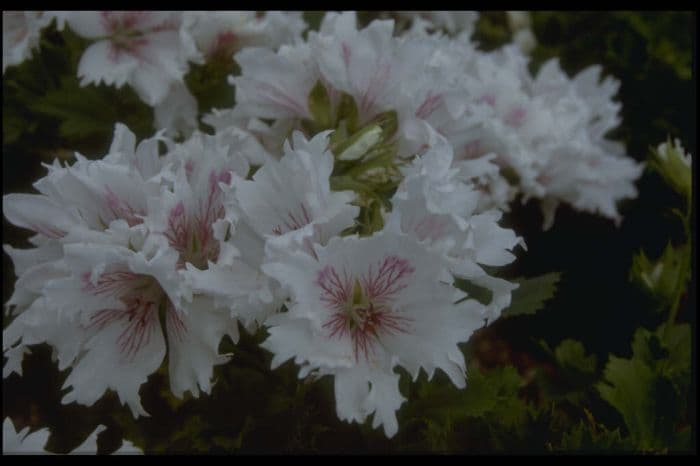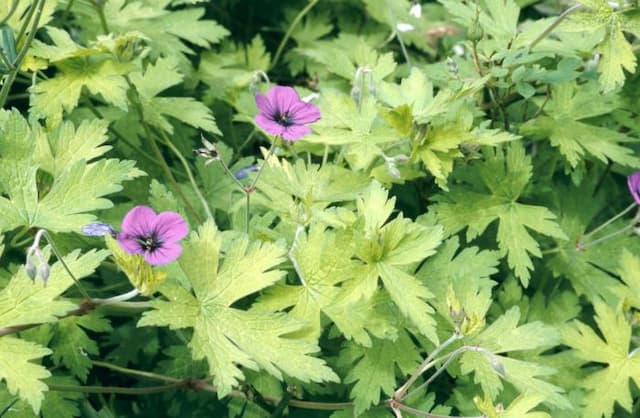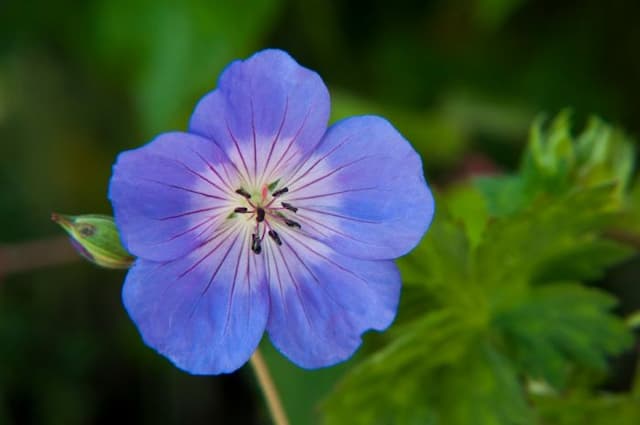Askham Fringed Aztec Geranium Pelargonium 'Askham Fringed Aztec' (R)

ABOUT
Pelargonium 'Askham Fringed Aztec' is a striking ornamental plant primarily known for its showy and unique foliage and flowers. The leaves of this plant are rounded, with a soft, velvety texture and a rich green color that can sometimes exhibit lighter tones, depending upon the variety. The edges of the leaves are notably serrated, giving them a fringed appearance that adds to the decorative look of the plant. The flowers are what set this variety apart, with their delicate yet vibrant display. They usually grow in clusters, showcasing an array of colors such as bright pinks, purples, or reds. Each petal on the flower can be edged with a contrasting shade, often appearing almost hand-painted with strokes of white or a deeper hue of the main color, creating a two-toned effect that is incredibly eye-catching. Additionally, the flowers can exhibit intricate patterns such as veining or speckling, further enhancing their visual appeal. Overall, Pelargonium 'Askham Fringed Aztec' is a visually attractive plant with detailed leaves and striking, multi-colored flowers that are sure to draw attention in any garden or as a potted display.
About this plant
 Names
NamesSynonyms
Askham Fringed Aztec Geranium, Fringed Aztec Pelargonium.
Common names
Pelargonium 'Askham Fringed Aztec' (R).
 Toxicity
ToxicityTo humans
Geraniums, including the Pelargonium 'Askham Fringed Aztec', are not considered highly toxic to humans. Ingesting parts of the plant might cause mild irritation in some individuals, such as an upset stomach, but they are generally not known to cause serious harm if consumed in small quantities.
To pets
Geraniums are known to be toxic to pets, especially dogs and cats. If a pet ingests any part of a Pelargonium 'Askham Fringed Aztec', it may experience symptoms such as vomiting, depression, dermatitis, and anorexia. In some cases, ingestion could potentially lead to more serious conditions like renal failure. It is important to keep this plant out of reach of pets to avoid any accidental poisoning.
 Characteristics
CharacteristicsLife cycle
Perennials
Foliage type
Evergreen
Color of leaves
Green
Flower color
Mixed
Height
1-2 feet (30-60 cm)
Spread
1-2 feet (30-60 cm)
Plant type
Herb
Hardiness zones
10
Native area
South Africa
Benefits
 General Benefits
General Benefits- Decorative Appeal: The Pelargonium 'Askham Fringed Aztec' offers ornamental value with its fringed, brightly colored flowers and attractive foliage.
- Easy to Grow: This geranium variety is known for being easy to care for, making it suitable for gardeners of all skill levels.
- Long Blooming Period: It typically has a long flowering season, providing color throughout the warmer months.
- Drought Tolerance: Once established, it has good resistance to short periods of drought.
- Pest Resistance: The plant has natural resistance to many common pests, reducing the need for chemical interventions.
- Container Gardening: Its compact growth habit makes it an excellent choice for pots, hanging baskets, and window boxes.
- Attracts Pollinators: Bees and butterflies are drawn to the flowers, which helps to pollinate surrounding plants.
- Versatile Landscape Use: Can be used in a variety of garden settings, including borders, beds, and as a ground cover.
 Medical Properties
Medical PropertiesThis plant is not used for medical purposes.
 Air-purifying Qualities
Air-purifying QualitiesThis plant is not specifically known for air purifying qualities.
 Other Uses
Other Uses- The scented leaves of geraniums can be used to flavor sugars and desserts, adding a subtle floral note to your sweet dishes.
- Geranium leaves can be placed among linens to impart a pleasant fragrance and potentially deter moths and other insects.
- Dried geranium flowers can be incorporated into potpourri mixes for their fragrance and to add a splash of color.
- The leaves of the geranium can be used to create natural dyes for fabrics, offering a spectrum of green and brown hues.
- Geranium plants are often used for educational purposes in schools to teach children about the life cycle of plants and basic horticultural skills.
- When grown in outdoor flower beds or borders, geraniums can be an effective ground cover, reducing weed growth due to their dense foliage.
- Pressed geranium flowers can be used artistically in crafts such as making bookmarks, cards, or other decorative paper items.
- Geraniums can serve as a living mulch in the garden, helping to retain soil moisture and regulate temperature around more delicate plants.
- The vibrant blooms of geraniums can be used in art projects, such as making natural collages or botanical prints.
- Some geraniums, when strategically placed, can help deter certain animals like deer and rabbits from munching on other garden plants.
Interesting Facts
 Feng Shui
Feng ShuiThe Geranium is not used in Feng Shui practice.
 Zodiac Sign Compitability
Zodiac Sign CompitabilityThe Geranium is not used in astrology practice.
 Plant Symbolism
Plant Symbolism- Healing: Pelargoniums, commonly known as "geraniums," have been used in traditional medicine, symbolizing health and recovery.
- Protection: Geraniums are often associated with warding off negative energies and are believed to offer spiritual protection.
- Friendship: With their bright and cheerful blooms, geraniums can represent closeness and positive relationships, reflecting the value of friendship.
- Comfort: The pleasant scent and homey appearance of geraniums are symbolic of comfort and soothing feelings.
 Water
WaterGeraniums, including the Pelargonium 'Askham Fringed Aztec', require consistent watering to keep the soil moist but not soggy. Allow the top inch of soil to dry out before watering again. Generally, watering thoroughly once a week should be adequate, but this could increase to every few days during hot weather. Be cautious not to waterlog the plant as this can lead to root rot. It is best to water with roughly one gallon of water each time, depending on the size of the plant and the pot.
 Light
LightGeraniums like bright, indirect sunlight and can benefit from some direct morning or evening sun. Place your Pelargonium 'Askham Fringed Aztec' near a sunny window where it can get at least 4-6 hours of sunlight per day. Avoid harsh midday sun that can scorch the leaves.
 Temperature
TemperatureGeraniums prefer temperate conditions and thrive in temperatures between 65°F and 75°F. The Pelargonium 'Askham Fringed Aztec' can tolerate a minimum temperature of around 50°F; however, they should be protected from frost, which means anything below 32°F can be harmful to the plant.
 Pruning
PruningPrune your Geranium to encourage bushy growth and to remove any dead or yellowing leaves. The best time for pruning is in late winter or early spring before new growth begins. Cut back up to one-third of the plant to shape it and promote new growth, and deadhead spent blooms regularly throughout the growing season to encourage more flowers.
 Cleaning
CleaningAs needed
 Soil
SoilGeranium 'Askham Fringed Aztec' thrives in well-draining soil with pH 6.0-7.0. A mix containing peat, perlite, and compost is ideal for providing necessary nutrients and drainage.
 Repotting
RepottingGeraniums like 'Askham Fringed Aztec' should be repotted every 1 to 2 years to refresh the soil and accommodate root growth.
 Humidity & Misting
Humidity & MistingGeranium 'Askham Fringed Aztec' prefers average indoor humidity levels, between 40-60%. Avoid excessively high humidity to prevent disease.
 Suitable locations
Suitable locationsIndoor
Place in bright, indirect light and water when topsoil is dry.
Outdoor
Ensure full to part sun and protect from frost.
Hardiness zone
10-11 USDA
 Life cycle
Life cycleThe Pelargonium 'Askham Fringed Aztec', commonly known as a type of Geranium, begins its life cycle as a seed which, when planted in a well-draining soil mix and provided with warmth, will germinate. The seedling stage follows germination, characterized by the emergence of cotyledons and then true leaves as the plant establishes itself. As it enters the vegetative stage, the geranium grows stems, leaves, and roots, and will thrive in conditions with plenty of light and moderate watering, becoming bushier as it matures. The flowering stage is marked by the development of vibrant blooms that can be fringed or feathered, which is a distinctive trait of this cultivar, typically appearing in warmer months. After pollination, the flowers will fade, and the plant may produce seeds if conditions permit, which can then be collected for propagation or will fall naturally to potentially start a new generation. As a perennial, the geranium may enter a period of dormancy during colder months, especially if grown outside of its hardiness zones, but with proper care, it can survive to regrow in the following season.
 Propogation
PropogationPropogation time
Spring-Early Summer
Propogation: Pelargonium 'Askham Fringed Aztec', commonly known as a variety of Geranium, is typically propagated through stem cuttings. The best time to propagate this plant is during late spring to early summer when the plant is actively growing. To propagate by stem cuttings, a healthy non-flowering shoot should be selected. A cutting of about 4 to 6 inches (approximately 10 to 15 centimeters) is severed from the parent plant just below a leaf node. The lower leaves are then removed, and the cut end is dipped in rooting hormone to encourage root development. The cutting is then planted in a pot filled with a well-draining soil mix and kept in a warm, well-lit area, but out of direct sunlight. Consistent moisture is maintained until the cutting establishes roots and shows new growth, indicating successful propagation.









